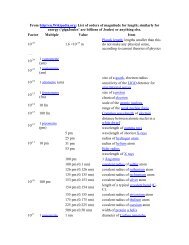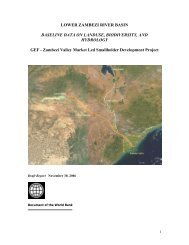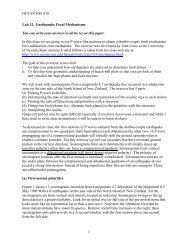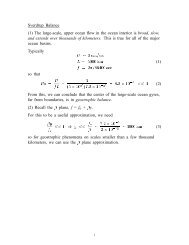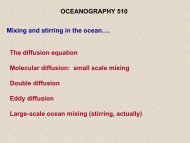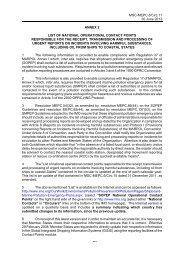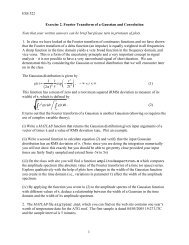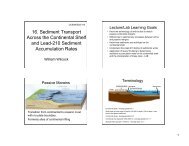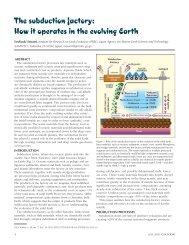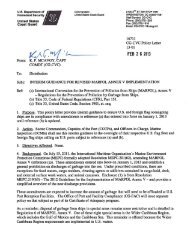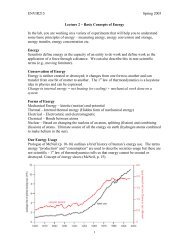2012 Seafloor Geodesy in Cascadia - William Wilcock - University of ...
2012 Seafloor Geodesy in Cascadia - William Wilcock - University of ...
2012 Seafloor Geodesy in Cascadia - William Wilcock - University of ...
Create successful ePaper yourself
Turn your PDF publications into a flip-book with our unique Google optimized e-Paper software.
observatory is connected to one <strong>in</strong>strumented mid-‐plate borehole and <strong>in</strong> addition is set to <br />
connect to IODP Hole 1364A on the marg<strong>in</strong> <strong>of</strong>f Vancouver Island for which WHOI has <br />
secured funds from the Keck Foundation to <strong>in</strong>stall borehole tiltmeters. Borehole fluid <br />
pressure monitor<strong>in</strong>g systems (CORKs), presently operat<strong>in</strong>g <strong>in</strong> these holes and <strong>in</strong> <br />
autonomous mode <strong>in</strong> several other boreholes on the Juan de Fuca plate, respond to seismic <br />
and aseismic stra<strong>in</strong> transients and serve as sensitive proxy volumetric stra<strong>in</strong> meters. <br />
On a bas<strong>in</strong> scale, NOAA operates an array <strong>of</strong> Deep-‐ocean Assessment and Report<strong>in</strong>g <strong>of</strong> <br />
Tsunami (DART) buoys as part <strong>of</strong> national and <strong>in</strong>ternational efforts to improve capabilities <br />
for the early detection and real-‐time report<strong>in</strong>g <strong>of</strong> tsunamis. Three <strong>of</strong> these buoys are <br />
deployed <strong>of</strong>f <strong>Cascadia</strong>. While the primary function <strong>of</strong> near shore DART buoys is to <br />
constra<strong>in</strong> the size <strong>of</strong> outgo<strong>in</strong>g tsunamis that will propagate across the ocean, there is <br />
clearly merit to predict<strong>in</strong>g the size <strong>of</strong> local tsunamis. One <strong>of</strong> the major challenges is to <br />
forecast tsunamis <strong>in</strong> the near field where the tsunami wave is <strong>of</strong>ten overwhelmed by the <br />
seismic event. A 17-‐month experiment at the Monterey Accelerated Research System <br />
(MARS) cabled observatory demonstrated the ability to make high resolution pressure <br />
measurements <strong>of</strong> micro-‐tsunamis, earthquakes, microseisms and <strong>in</strong>fra-‐gravity waves <br />
(Paros et al., <strong>2012</strong>). <br />
After a decade-‐long hiatus <strong>in</strong> the acquisition <strong>of</strong> deep seismic reflection data on <strong>Cascadia</strong> <br />
marg<strong>in</strong>, there have been several reflection experiments <strong>in</strong> the region this year us<strong>in</strong>g the <br />
R/V Langseth. Seismic reflection imag<strong>in</strong>g <strong>in</strong> subduction zones is an important complement <br />
to seismic and geodetic monitor<strong>in</strong>g. For example seismic images are critical for mapp<strong>in</strong>g <br />
structural features to better assess the extent <strong>of</strong> megathrust lock<strong>in</strong>g and whether the <br />
rupture zone extends seaward to the trench. They are necessary to assess the <strong>in</strong>fluence <strong>of</strong> <br />
geometrical irregularities on the subduct<strong>in</strong>g plate such as seamounts and <strong>of</strong> structure <strong>in</strong> <br />
the overrid<strong>in</strong>g plate <strong>in</strong> creat<strong>in</strong>g megathrust segmentation. <br />
Given all the <strong>in</strong>vestments <strong>in</strong> monitor<strong>in</strong>g <strong>in</strong>frastructure and scientific <strong>in</strong>itiatives, it is <br />
strik<strong>in</strong>g that there is not yet a community effort <strong>in</strong> place to obta<strong>in</strong> seafloor geodetic data <br />
from the <strong>Cascadia</strong> subduction zone. <br />
<strong>Seafloor</strong> Geodetic Techniques <br />
On land, the availability <strong>of</strong> dense networks <strong>of</strong> GPS stations and maps <strong>of</strong> ground <br />
displacement obta<strong>in</strong>ed us<strong>in</strong>g <strong>in</strong>terferometric synthetic aperture radar (InSAR) has <br />
revolutionized our ability to understand tectonic and volcanic processes. Because the <br />
oceans do not transmit the electromagnetic waves that enable these techniques, geodetic <br />
measurements on the seafloor are much more challeng<strong>in</strong>g. There are a variety <strong>of</strong> <br />
complementary approaches to seafloor geodesy with ongo<strong>in</strong>g technique development <br />
efforts focused on improv<strong>in</strong>g the accuracy and reduc<strong>in</strong>g the costs <strong>of</strong> observations. <br />
Offshore GPS or GPS-‐Acoustics comb<strong>in</strong>es k<strong>in</strong>ematic GPS with precision acoustic rang<strong>in</strong>g <br />
to seabed transponders from a sea surface platform to track the horizontal motion <strong>of</strong> the <br />
seafloor (Figure 6). Conventionally the platform is a ship and acoustic rang<strong>in</strong>g is used to <br />
locate the ships horizontal position relative to the center <strong>of</strong> a small network <strong>of</strong> seafloor <br />
12



